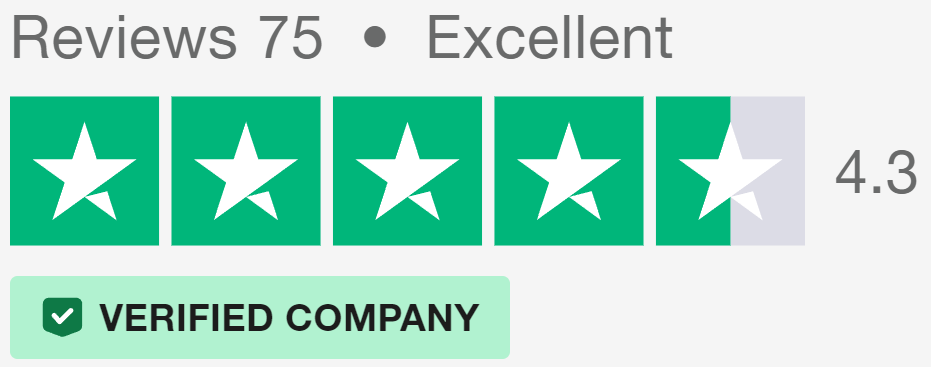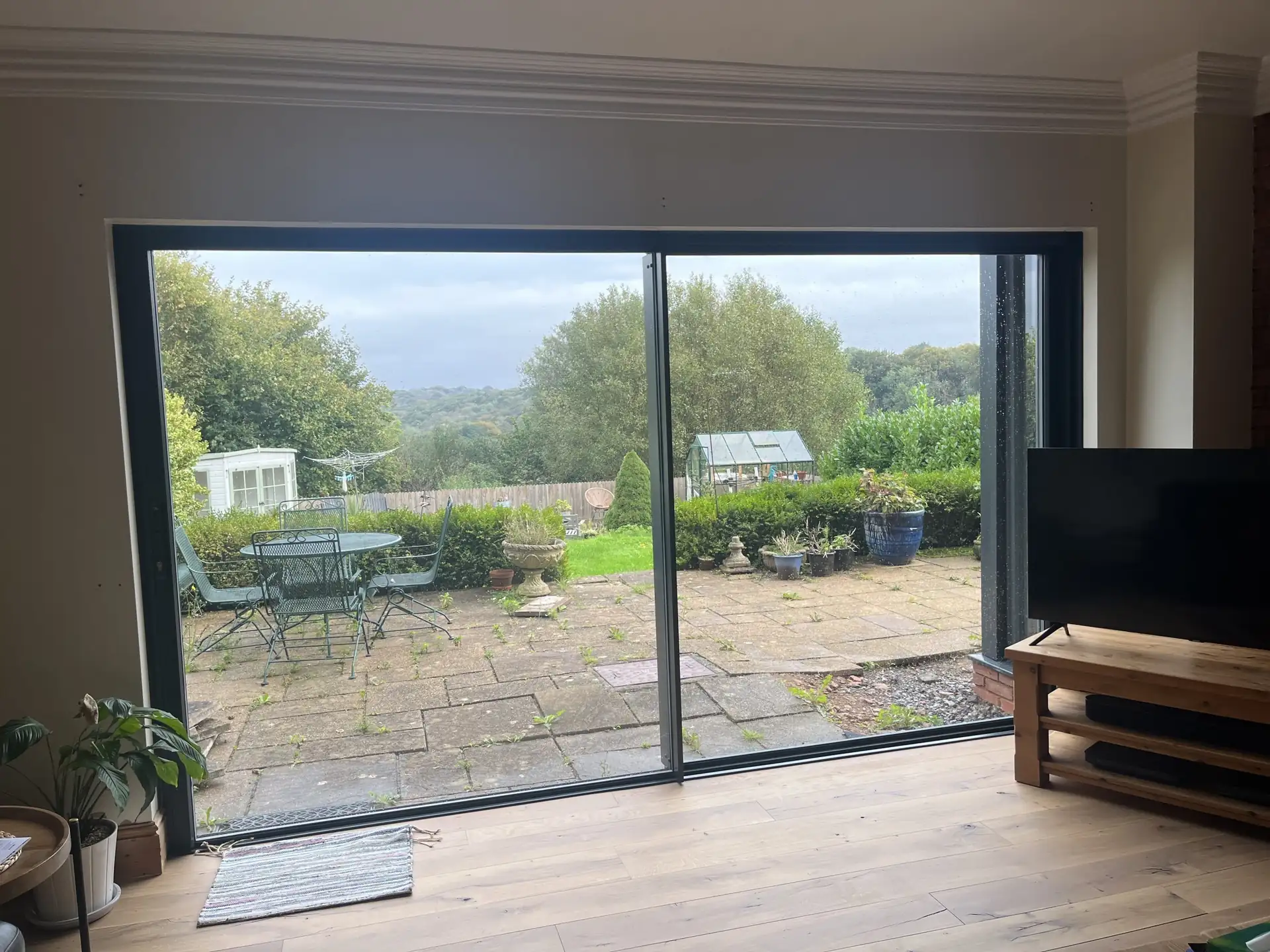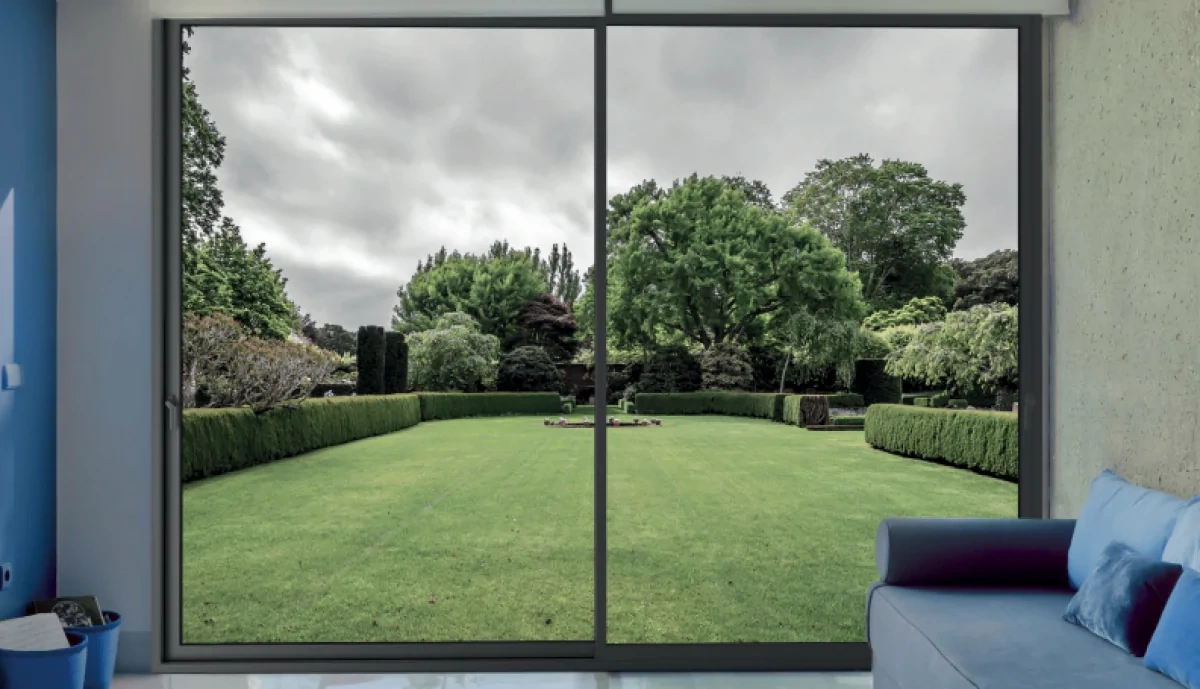Secure Patio Doors: What to Look For
Table of Contents

Choosing well-made patio doors with strong security features helps prevent break-ins and keeps your home safe. Modern secure patio doors combine robust materials with advanced locking systems to stop intruders, while letting you enjoy views of your garden and plenty of natural light. British homeowners increasingly prioritise security when selecting new patio doors, moving beyond basic locks to comprehensive protection systems.
Types of Patio Doors and Their Security Challenges
Patio doors come in several styles, each with distinct security strengths and potential weak spots. While all modern designs must meet basic security standards, some types naturally offer better protection against break-ins than others. The key to choosing secure patio doors lies in understanding how different designs tackle security challenges.

Common Patio Door Styles
Sliding patio doors run along tracks and typically feature two or more glass panels, with at least one that moves horizontally. The moving panel sits on rollers and slides past the fixed panel, making these doors popular for rooms where space is limited.
Their security depends heavily on the quality of the tracks and locking mechanisms. Modern secure patio doors in the sliding style often include anti-lift devices and multi-point locks built directly into the frame.
Sliding door alternatives include bifolding doors, which use multiple glass panels that fold like a concertina. Each panel connects to the next with heavy-duty hinges, creating a strong barrier when locked. The numerous joining points between panels can actually improve security, since there are multiple locking points along the frame. Unlike traditional patio doors, bifolding designs spread the force of any impact across several points, making them naturally resistant to forced entry.
French patio doors open outward or inward from a central point where the two doors meet. Unlike sliding or bifolding designs, French doors rely on their frame strength and multi-point locks rather than tracks or runners. This traditional design often includes additional security features like shoot bolts at the top and bottom of each door. Many secure patio doors in the French style now come with reinforced frames and advanced locking systems built into the door leaf itself.
Weak Points in Each Design
Sliding doors face unique challenges due to their horizontal movement system. Without proper anti-lift devices, criminals might try to force the doors off their tracks. The large glass panels in sliding designs also need extra reinforcement to prevent them from being pushed inward. Manufacturers of secure patio doors have developed specialised mechanisms to prevent lifting, including hidden security pins and anti-bump cylinders.
The multiple joints in bi-fold doors require precise alignment for proper security. Each hinge point needs robust locking mechanisms, while the tracking system must be firmly anchored to prevent tampering. Poor installation can leave gaps between panels that weaken overall security. Modern secure patio doors address these vulnerabilities with interlocking mechanisms between panels and reinforced corner joints.
French doors concentrate force at the meeting point between the two doors. This central joint needs reinforced locking systems and robust frame materials to withstand attempted break-ins. The hinges also require careful positioning and strong fixings to prevent them from being prised apart. Advanced secure patio doors now feature hidden hinge bolts and multi-point espagnolette locks that engage at several points around the frame.
Key Security Features Across Door Types
Every type of patio door shares some fundamental security requirements. Multi-point locking systems, toughened glass, and sturdy frames form the foundation of door security. The frame material affects both strength and longevity, with aluminium and composite frames offering excellent resistance to forced entry. While older patio doors might rely on simple locks and basic glass, modern secure patio doors incorporate layers of protection through advanced materials and sophisticated locking mechanisms.
Security standards for patio doors have improved a lot over recent years. British Standards Institution (BSI) certification now sets strict requirements for secure patio doors, testing them against various attack methods. Independent testing laboratories assess factors like glass strength, lock durability, and frame resistance to ensure doors meet these rigorous standards. Police-backed Secured by Design certification provides additional assurance, with approved secure patio doors undergoing even more stringent testing.
Regular maintenance is important in keeping all types of patio doors secure too. Locks need periodic lubrication, while tracks and runners require cleaning to prevent debris from affecting smooth operation. Professional installers can spot early signs of wear that might compromise security, making annual inspections worthwhile for any secure patio doors.
How Burglars Break Through Patio Doors
Despite modern security measures, determined burglars still sometimes target homes through patio sliding doors. Quick break-ins often happen when potential burglars spot obvious weaknesses, like old locks or flimsy frames. Yet many of these break-ins could be prevented with secure patio doors and proper precautions.
Common Entry Methods
Some intruders try to lift sliding doors off their tracks, especially with older models that lack anti-lift blocks. This technique exploits the sliding mechanism itself – once a door lifts clear of its track, the locks become useless. Many secure patio doors now come with hidden pins that prevent lifting, even if someone manages to tamper with the visible security hardware.
Lock manipulation remains a frequent technique, with thieves attempting to force or pick basic cylinder locks. Older glass doors often used simple locking points that could be broken with basic tools. Modern secure patio doors use advanced cylinders and multiple locking points to stop these attacks, making quick break-ins much harder.
Force sometimes works on poorly fitted doors, especially if the frame has warped over time. Burglars might try to bend the frame enough to pop the lock, or simply break through weak points near the handle. Most patio door security now includes reinforced frames (especially in metal patio doors) and impact-resistant glass panels, but older installations remain at risk.

Why Patio Doors Are Often Targeted
Back gardens provide cover for break-ins, letting intruders work without being seen from the street. Dense hedges and poor lighting make secure patio doors particularly important for homes with secluded gardens. High-quality patio door security becomes essential when natural surveillance is limited.
Quick escape routes attract thieves, who prefer easy access to back alleys or neighbouring gardens. Large glass panels let them check if anyone’s home before attempting entry. They might watch houses for days, learning family routines and identifying the best time to strike.
Many homeowners forget to lock their doors properly, especially during warm weather. Some leave windows open next to locked patio doors, negating even the strongest security features. Others rely too heavily on basic locks, unaware that modern secure patio doors offer much stronger protection.
Common Tools and Techniques
Burglars often use simple tools: screwdrivers to force locks, glass cutters for older single-glazed panels, and plastic cards to slip catches. Professional thieves might bring more sophisticated equipment, but most rely on quick, basic methods. They target homes without obvious security upgrades, knowing that older patio doors take less time and effort to breach.
Break-in attempts typically focus on door corners and locking points. Crowbars provide leverage against frame joints, while lock-snapping tools can break cheaper cylinders in seconds. Properties with outdated glass doors face higher risks, as older materials lack the strength of modern security glass.
Police reports show most patio door break-ins happen through brute force rather than sophisticated methods. Many burglars simply smash glass panels or kick doors until they give way. This makes noise but works quickly – they count on neighbours ignoring short bursts of sound. That’s why multi-layer security, starting with properly secure patio doors, matters more than any single security feature.
Old vs New Patio Doors
Many older patio doors lack basic safety measures that come standard today. The security features built into modern secure patio doors show just how far door technology has advanced. A single layer of security no longer suffices – today’s doors combine multiple protective elements.
Outdated Security Features
Older patio doors often relied on simple catches and basic key cylinders. These basic locks proved easy to force open, with some thieves managing to lift doors straight off their tracks. Single-glazed panels offered minimal resistance to determined intruders, while thin frames could bend under pressure. Basic security bars might have added protection, but often looked unsightly and could trap occupants during emergencies.
Earlier door designs focused more on looks than security. Flimsy aluminium frames and weak locking points made older installations vulnerable to attacks. Even with added locks, these doors remained weak points in home security. Patio door security has improved immensely since then, with modern systems offering much stronger protection.
The limitations of past designs become clear when examining break-in patterns. Older doors often failed at their weakest points – usually around locks or frame joints. Simple cylinder locks could be snapped or picked, while basic glass panels shattered easily. Many homeowners tried adding surface-mounted bolts, but these quick fixes rarely matched the protection of modern secure patio doors.

Modern Security Standards
Today’s secure patio doors must pass strict testing before reaching the market. Each component undergoes rigorous trials to prove its strength against forced entry. Modern safety glass resists impacts and prevents clean breaks, while multi-point locks engage at several positions around the frame.
Advanced locking systems for glass doors now include anti-snap cylinders and reinforced strike plates. Hook bolts grip deeply into the frame, making it nearly impossible to force doors apart. Some secure patio doors even include magnetic sensors that connect to home alarm systems, adding an extra defensive barrier against break-ins.
Frame materials have evolved over time, with modern profiles offering superior structural strength. Internal reinforcement prevents bending or warping, while precise engineering eliminates gaps that thieves might exploit. Advanced secure patio doors use thermal breaks and multiple chambers within their frames, improving both security and insulation.
Industry Standards and Testing
The most secure patio doors now carry PAS 24 certification, proving their resistance to common attack methods. Test houses simulate real break-in attempts using various tools and techniques. Doors must withstand these attacks for specific time periods to earn their security ratings.
Manufacturing improvements mean better quality control and consistency. Computer-designed components fit together precisely, eliminating weak points found in older doors. Modern manufacturing also allows for innovative security features without compromising the door’s appearance or operation.
British Standards now demand much more from home security products. Today’s doors need sophisticated locking mechanisms, strong frames, and safety glass as standard features. While older patio doors might have met past requirements, they fall short of current expectations for home security.
Essential Security Components of Secure Patio Doors
A mix of physical and mechanical features work together in modern secure patio doors. High-quality secure sliding patio doors protect homes through multiple defensive layers, from sturdy frames to advanced locking systems.
Multi-Point Locking Systems
Anti snap locks form the core of modern door security. Unlike basic cylinder locks, these systems resist tampering and forced entry attempts. Many secure patio doors now include three or more locking points that engage simultaneously when you turn the key, anchoring the door firmly into its frame at multiple positions.
Cylinder guards protect the main lock mechanism from drilling or manipulation. Steel plates inside the lock housing stop potential intruders from breaking the cylinder to gain entry. Advanced key systems also prevent unauthorised copying, letting you control exactly who has access to your property.
Hook locks grip deeply into the frame when engaged, making it nearly impossible to force the door open. These hooks spread the force of any impact across multiple points rather than concentrating it at a single spot. Well-made sliding doors often combine hook locks with additional security bolts at the top and bottom of the frame.
Toughened and Laminated Glass
Modern secure patio doors use specialised glass designed to resist breakage. When broken, toughened glass shatters into small, rounded pieces rather than dangerous shards. This makes quick access through broken panels much harder while also protecting against accidental injury.
Laminated glass adds another protective barrier by sandwiching a tough plastic layer between two glass panes. Even if both panes break, the plastic holds them together and blocks entry. This technology, originally developed for car windscreens, has become a popular choice for patio doors in vulnerable locations.
Some manufacturers offer triple-glazed security panels for extra protection. These energy efficient patio doors combine multiple glass types with gas-filled spaces between panes, creating a robust barrier that’s difficult to breach quickly and quietly.
Frame Materials and Strength
Wooden doors might look traditional, but modern timber frames use engineered wood and reinforced cores for superior strength. Proper treatment prevents warping and maintains the tight tolerances needed for security features to work correctly. Many secure patio doors in heritage properties now combine traditional wooden appearance with hidden steel reinforcement.
Aluminium frames offer excellent structural strength without bulky profiles. Internal bracing and multiple internal chambers create rigid structures that resist forcing and flexing. Modern aluminium secure patio doors often include thermal breaks that improve both insulation and security by preventing the frame from being easily bent.
Anti-Lift Devices
Special security options prevent sliding doors from being lifted off their tracks. Hidden pins engage automatically when the door closes, while anti-lift blocks built into the frame stop upward movement. These features come standard on most secure patio doors today, addressing one of the most common vulnerabilities in older sliding designs.
Track designs have also improved, with deeper channels and stronger materials preventing forced removal. Some systems include backup security measures that activate if someone tries to lift the door, effectively locking it more firmly in place rather than allowing removal.
Smart Security Features in Secure Patio Doors
Secure patio doors now integrate with modern home security systems. Advanced electronic features add new protective layers while making doors easier to monitor and control. Proper patio door security now extends beyond physical barriers into digital protection.
Digital Locks and Access Control
Smart locks replace traditional cylinders in many secure sliding doors today. These systems let you control access through your phone, track who enters and leaves, and receive alerts about unusual activity. Some manufacturers offer patio doors with built in blinds that automatically close when you lock up, adding privacy alongside security.
Digital systems can automatically check that secure patio doors are properly closed and locked. If someone leaves a door unlocked or ajar, you’ll get an immediate notification. Many systems also track attempted break-ins, recording the time and method of any tampering.
Security Sensors and Monitoring
Motion sensors near patio doors detect movement in vulnerable areas. Modern secure patio doors often include integrated contact sensors that connect to home security systems. These sensors work alongside external cameras to create complete coverage of entry points.
Window and door contacts show exactly when doors open or close. Some systems can distinguish between normal use and forced entry attempts, reducing false alarms while maintaining vigilance. Advanced monitoring options let you check your doors’ status from anywhere, giving you control even when you’re away from home.
Complete Security Beyond the Door
Proper secure patio doors form just one part of home protection. Extra measures strengthen security while deterring opportunistic thieves. Many homeowners add layers of protection with security in mind, especially for sliding garden doors that open onto secluded areas.
Security Lighting
Motion-activated lights near patio doors startle intruders and draw attention to suspicious activity. Proper lighting removes the cover of darkness that burglars prefer, making secure patio doors even harder to breach. Well-placed lights also help you spot potential threats before opening your doors at night.
Timer-controlled lighting creates the impression of occupancy when you’re away. Lights that switch on at varied times look more natural than fixed schedules. Strategic placement matters – angles that create shadows could actually help hide intruders rather than expose them.

CCTV and Cameras
Modern cameras provide clear footage day and night, catching details that might help identify intruders. Positioning matters – cameras should cover the approach to sliding doors as well as the doors themselves. Video doorbells with motion sensors can alert you to people lingering near your secure patio doors, even if they don’t ring the bell.
Network cameras let you check your doors remotely through your phone. Some systems save footage to secure cloud storage, ensuring evidence remains available even if cameras are damaged. Advanced features like person detection reduce false alarms from pets or windblown objects.
Most secure patio doors work better with visible security cameras nearby. The mere presence of cameras often deters opportunistic thieves. However, cameras need proper positioning – if they’re too high or poorly angled, they might miss important details during attempted break-ins.
Physical Barriers
Security grilles provide extra protection without permanent changes to your doors. Removable bars can strengthen secure patio doors when you’re away, then store away when you want clear views. Modern designs look less institutional than older security grilles while providing similar protection.
Garden layout affects door security too. Thorny plants under windows and near doors create natural barriers. While plants alone won’t stop determined thieves, they make quick access harder and might leave evidence if someone forces their way through.
Proper fencing and gate locks limit access to areas with patio doors. High side gates with good locks force potential intruders to find riskier entry routes. Adding patio door security through garden design works especially well when combined with other measures like lighting and cameras.
We’d Love to Help You
Vision Glass Doors is a designer, manufacturer, and installer of premium door systems. We are a family run business with over 20 years’ experience and 5,000 installations across the UK.
Our leading range of door systems include Ultra Slim – Slide and Turn Doors, Slimline Sliding Patio Doors and Frameless Glass Doors. Suitable for various internal and external applications, they are applicable to residential and commercial projects.
Click Quick Quote Online for a free quotation within 24 hours. Alternatively, call or email us on 01582 492730 or at info@visionglassdoors.co.uk.

